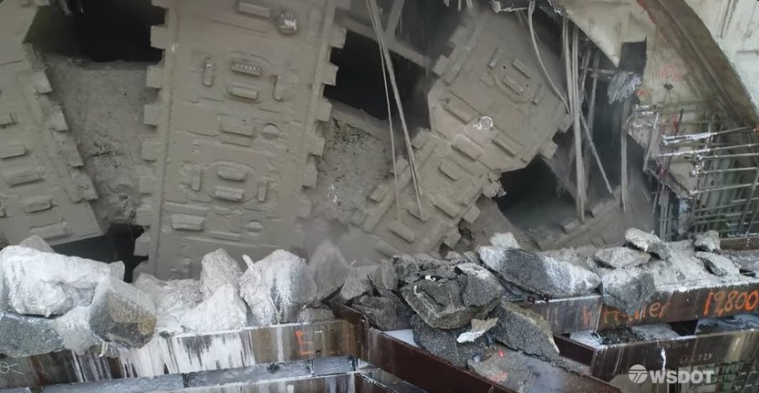Three years behind schedule, Bertha, the boring machine carving out a gigantic underground highway beneath downtown Seattle, poked through the end of its tunnel this week. After a spectacular breakdown early in the boring journey, the highway tunnel project, originally slated to cost $3.1 billion, is now expected to cost at least $4 billion when all is said and done.
Who's going to pay? Seattle residents never embraced the highway tunnel -- they voted against it in 2007, then were cajoled by project boosters into voting for it four years later. But they may have to pay for the overruns, as Republican state lawmakers try to pin those costs on the city of Seattle [PDF].
Doug Trumm at the Urbanist reports on the risk that the city will end up eating the excess cost of a project it never needed:
From the outset of the project, the popular opinion of replacing the Viaduct has been met with skepticism. In 2007, Seattle voters were presented with an advisory vote on competing Viaduct replacement options: elevated and tunneled. More than 100,000 voters turned out to register their widespread rejection of both proposals with 70% against the tunnel and 55% against an elevated version. This was in spite of civic leaders like Mayor Greg Nickels pushing the tunnel and years of public campaigning for replacement. But that didn’t stop backers of the tunnel -- Governor Gregoire, the Downtown Seattle Association, the Port of Seattle, and waterfront interests -- from turning the levers in favor. Only after another four years of campaigning did this Seattle brain trust materialize a low-turnout win in 2011 on a non-binding advisory vote for building the tunnel.
Billed as a way to reconnect Downtown Seattle to its waterfront, what wasn’t made clear at the time was that the new tunnel would not remove the need for a wide surface-level highway. Since then, the auto-focused surface highway plan has come into focus and it’s unlikely to create an especially pleasant experience for pedestrians or bicyclists. With ferry queuing lanes on the new Alaskan Way, the replaced road will balloon out to nine lanes wide.
The other elephant in the room -- elephant also being the symbol of the Republican Party -- while exurban Republicans bill the Viaduct replacement as a local Seattle project, in reality it will be used by motorists from across the region. The project has no Downtown exits showing that it’s a project allowing travel through Seattle rather than serving typical trips within the city itself. And while the total daily traffic counts on Seattle Department of Transportation (SDOT) right-of-way has been flat for years, much of the increased freeway congestion (WSDOT right-of-way) is linked to suburban sprawl and long commutes. Residents of Seattle increasingly use transit, which has allowed transit to absorb much of the trip demand from the city’s rapidly growing population. Our population has grown by more than 100,000 people since 2004, but SDOT’s daily traffic estimate is lower today than it was in 2004. Seattle itself doesn’t need the increased capacity that the tunnel and surface highway together provide; if anyone does, it’s the suburbs.
Trumm's full post is worth a read -- it's a great account of the politics that foisted this damaging highway project on the city.
More recommended reading today: Greater Greater Washington breaks down new Census data showing that sprawling metros are seeing faster population growth than more compact regions. And NextSTL breaks down the vote in St. Louis to expand transit and reject a sports stadium.






